 |
| Source: Internet |
Kedarnath - the mere mention of this word brings before my eyes, the TV footage that showed buildings collapsing like a pack of cards, a huge pileup of dead bodies right in front of the temple, entire villages and towns being swept away in the devastating Himalayan tsunami in 2013. However, the temple and the people inside were miraculously saved - a testament to the resilience and power of faith. Probably, that was the day when I quietly sowed the seed of visiting this place, which till then was unknown to me.
Exactly 10 years later, I manifested this wish when our family and a few others booked our customised Char Dham Yatra with GoTravelTales.
On April 25th, we set forth on our 12-day journey. When I realised that our journey coincided with 'Shankara Jayanti', the birth anniversary of the great philosopher and saint Adi Shankaracharya, I was double assured that we had his blessings for our spiritual expedition.
Chardham Yatra consists of four sacred sites, Yamunotri, Gangotri, Kedarnath and Badrinath (listed in the clockwise order in which they are usually visited) - all located in the Uttarakhand state (aka DevBhoomi) and situated in the higher reaches of the Himalayas.
Gone are the days when this yatra was undertaken during the last leg of one's life term owing to its great challenges in terms of rugged Himalayan terrain and harsh climate. Now, people across age barriers are embracing it, thanks to infrastructure, technology and awareness. The difficulties faced during the journey hold a spiritual significance as they test one's devotion and dedication to the divine.
On day one, we flew from Bangalore to Dehradun and drove to Rishikesh, the abode of sages. Known as the 'Yoga Capital of the World', it is a melting pot of spiritual seekers, tourists and adventure enthusiasts.
Rishikesh
.jpg) |
River Ganga in Rishikesh
|
.jpg) |
| Brightly lit Ram Jhoola |
We headed towards Parmarth Niketan Ashram and Gita mandir, crossing Ram Jhoola and making our way through the crowd. Ram Jhoola is an iconic suspension bridge over the Ganges, offering panoramic views of the river. Ganga Aarti is held on the ghats of the ashram in the evenings.
The next day, left for Yamunotri via Mussoorie, Barkot and visited Kempty Fall en route.
Yamunotri
Drove to Jankichatti early in the morning to start the 6km trek to Yamunotri. As this was our first destination, all our batteries were fully charged as we started trekking. It was a steep ascent to the top.
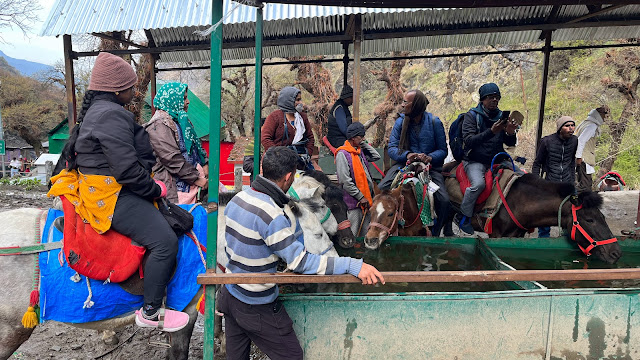 |
| Mules hydrating themselves before the trek |
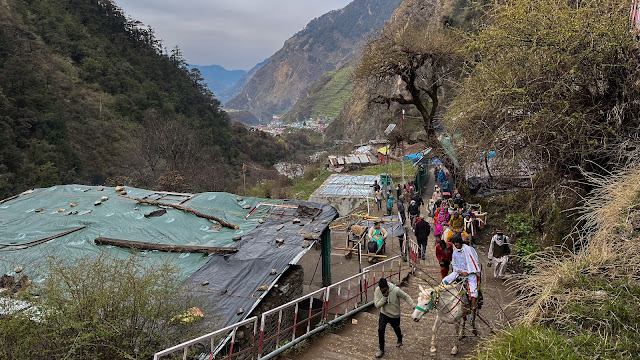.jpg) |
| Pilgrims on their way to Yamunotri |
There is a natural hot spring, Surya Kund in the temple premises where people take a dip for spiritual cleansing. We were surprised to see that rice which was dipped in this spring would get cooked instantaneously and was being offered as prasad to devotees. We had to leave immediately after the pooja as the weather was getting bad. The entire descent was quite damp which dampened our spirits as well.
.jpg) |
| Didsari Hanging Bridge over Bhagirathi river |
.jpg) |
| Bird's eye view of Uttarakhand's beauty |
On the fourth day, we drove to Uttarkashi (a.k.a Soumya Varanasi) and visited Vishwanath temple. This temple is one of the oldest Shiva temples in Northern India, constructed in 1857 and is one of the twelve jyotirlingas.
Uttarkashi
 |
| Vishwanath temple, Uttarkashi |
Right in front of this temple is Shakti temple which has a huge Trishul(6 mts in height and 90 cm in diameter) erected inside. This was supposed to have been thrown on the devils by the Goddess Durga.
 |
| Shakti Temple, Uttarkashi |
Harshill
Harshil is a picturesque village in the Himalayas's lap, situated on river Bhagirathi's banks. Known as the 'Mini Switzerland of India', it has stunning natural beauty, and a serene environment and offers panoramic views of the surrounding Himalayan peaks. This place also had a lot of apple orchards which were white-washed with apple blossoms.
 |
| Apple trees |
 |
| Apple blossoms |
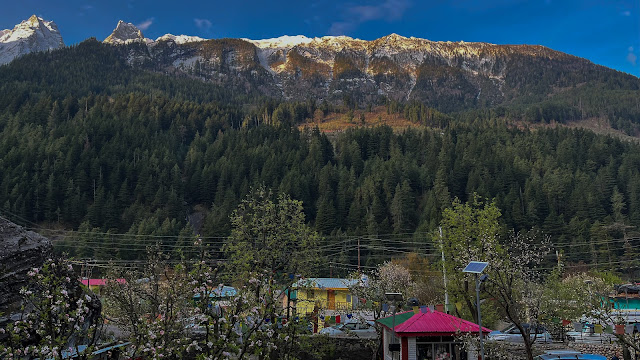.jpg) |
| Harshill, a village in Uttarkashi |
The next day early morning left towards Gangotri.
Gangotri
 |
| En route Gangotri |

The journey was enchanting as we witnessed a couple of scenic spots where Bhagirathi was gracefully winding its way through the landscape. It was a sight to behold.
The waters of Bhagirathi are a captivating shade of turquoise blue. All along its course, the river is embraced by the elegant presence of deodar trees on both sides, creating a harmonious blend of colours that soothes our senses. This is further enhanced by a breathtaking backdrop of snow-peaked Himalayan mountain ranges.
It was truly an unparalleled charm of nature's masterpiece which left a long-lasting impression on me and I felt fortunate to witness it.
.jpg) |
| A mesmerising view of river Bhagirathi flowing gracefully through the mountains |
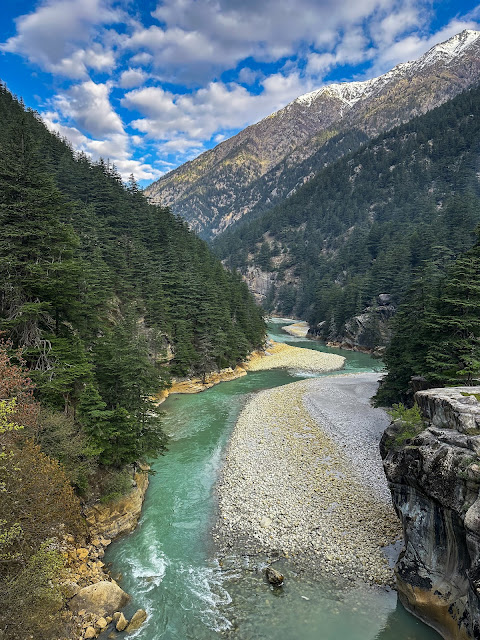.jpg)
Gangotri is easily accessible, unlike Yamunotri. You will find yourself amidst towering Himalayan peaks reaching the sky. Deodar trees and alpine shrubs dot the landscape providing refreshing visual contrast to the rocky terrain.
.jpg) |
| Rocky terrains of Gangotri |
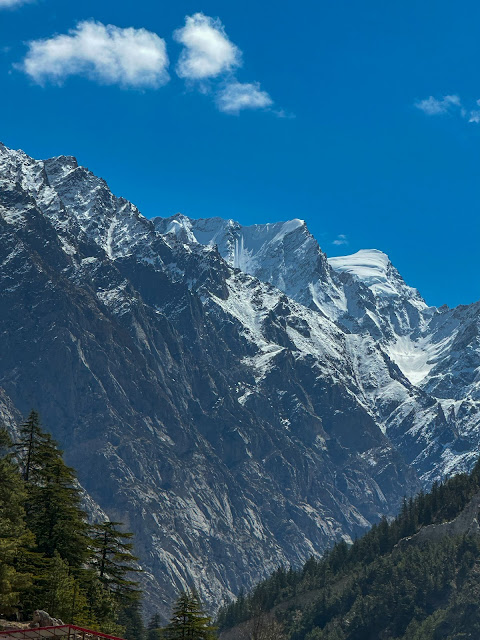.jpg) |
| Gangotri peaks |
The pathway to the temple is dotted with numerous shops selling pooja items as well as eating joints. As you reach the temple premises, you will see the Bhagirathi River with its pristine turquoise-blue water flowing nearby and adding a touch of serenity to the scene. The sound of the flowing water complements the tranquil atmosphere and creates a soothing melody that resonates with the spiritual atmosphere all around.
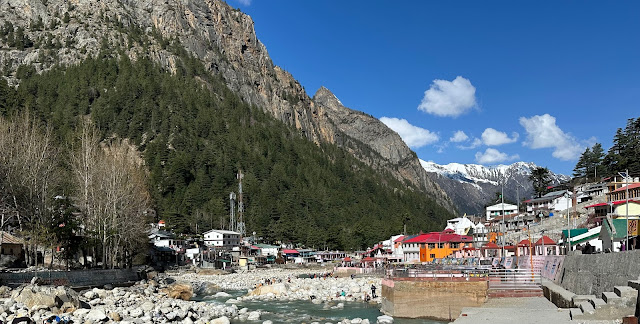 |
| Gangotri landscape |
 |
| Gangotri temple |
Proceeding directly to the riverbank, immersed ourselves in the icy waters of the sacred river for a refreshing dip. A sense of calm engulfed me after the bath. Following the dip, we presented our offerings and conducted an aarti ceremony to honour Mother Ganga. Subsequently, we entered the temple premises which was by then quite crowded due to the influx of visitors.
On our return journey, we cherished hot Jilebis which perfectly complemented the chilly weather.
.jpg) |
| Hot n sweet Jilebis |
On the subsequent day, we drove to Guptkashi for an overnight stay and then proceeded towards Sonprayag to embark on the Kedarnath trek at 4 in the morning.
.jpg) |
| Rudraprayag, confluence of Alakananda from Badari(left) and Mandakini from Kedar(right) |
.jpg)
 |
| Views near Tehri Dam, the tallest dam in India and the 12th-tallest in the world |
.jpg)
.jpg)
Kedarnath
Of the four dhams, Kedarnath was the destination we had eagerly anticipated. However, our plans took an unexpected turn as the rain began to fall, leading to the suspension of vehicle movement well before reaching Sonprayag. Faced with limited options, we initiated our journey on foot.
Upon reaching Sonprayag, we were met with a lengthy queue. Before we could even reach the registration counter, the clock struck 11:30, and we learnt that the day's trek at Kedarnath had been called off due to deteriorating weather conditions uphill. However, we were determined not to return without experiencing the divinity of the place. Hence, we secured a room close to the counter, and our plan was to either make every possible effort to continue our journey on the same day or, in the worst-case scenario, set off early the following morning. Our perseverance paid off when a compassionate policeman, who had been observing us, took pity and granted us permission to move ahead towards Gaurikund. Kedarnatheshwara had blessed us in disguise. Gaurikund serves as the initial point of the trek leading to Kedarnath, and it is where Goddess Gauri underwent penance to earn the favour of Lord Shiva.
This was just the initial hurdle. By the time we commenced our ascent, the clock had already struck 3 p.m., a rather late hour to start the trek on the rugged terrain. Horsemen were returning from the summit and were unprepared for another journey so late in the day. It typically takes anywhere between 6 to 10 hours to reach the top on foot, and given the age range of our group, this seemed like an impossible task. However, through the grace of God, we managed to secure mules for all of us, albeit at very high prices and began our trek.
.jpg) |
| Views en route Kedarnath |
The difficult terrain and vagaries of the weather are never a deterrent to the people who visit this place. All kinds of people, both old and young, some of them even carrying small children in their arms, and a few others lacking adequate warm clothing or suitable footwear were seen climbing up and down throughout our voyage.
.jpg) |
| Trekking path to Kedarnath |
The mule ride proved to be quite frightening, as its owner would neglect to grasp the nose thread quite a few times, causing the mule to attempt to bolt, resulting in my terrified screams. However, options were limited, so I resolved to remain atop the mule, reciting the panchakshari mantra. It was a mindful prayer for the next 5-6 hours. How I wish I could be in that state all the time! Some travellers journeying along the trail were engaged in fervent prayers to the Lord. We were in divine alignment with all others who were ascending with us.
.jpg) |
| Snow-clad peaks of Kedarnath |
Lady Luck smiled at us as the weather took a turn for the better and became quite pleasant. The environment around me was truly breathtaking, although my unease from riding the mule and the constant fear of slipping detracted from my ability to fully appreciate it. As we approached our destination, the sky was pristine blue and the full moon radiantly illuminated the snow-clad blue-hued mountain peaks. This sight evoked in me an image of Lord Shiva adorned with the moon nestled in his hair.
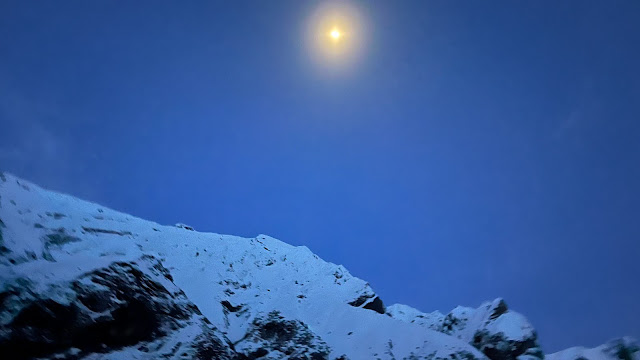 |
| Moonshine in Kedarnath |
We dismounted the mule and began walking, hoping to refresh our eyes with the enchanting view of the sacred temple. This stretch of the journey was immersed in darkness, stars were twinkling above and lit up the ink-dark sky. The path beneath us was a slushy mix of snow. Despite these challenges, we continued on foot, yet the temple remained elusive in the distance. Eventually, after a considerable walk, we caught sight of the temple, and the realization dawned upon us that we had covered a distance of nearly 2.5 kms. The sight of the temple sent chills down my spine, a mix of awe and reverence.
 |
| My first glimpse of the temple |
Given that it was nearly 11 p.m., the temple doors were closed, prompting us to make our way directly to our hotel rooms which were hardly 50 meters from the temple. It was then that we recognized our hunger, having gone without a meal since breakfast. Fortunately, luck was on our side as we managed to find a place to serve dinner at that late hour. With the bitter cold seeping into the bed and thick blankets, we settled down to rest, seeking some reprieve from the frosty weather and hoping to catch a few hours of sleep.The next day, got up in the wee hours and reached the temple by 4.30 am. The temple was still closed people had already lined up for darshan. Chantings of the Mahanyasa mantra were reverberating in the air. Mountains, wholly covered with snow, were forming a picture-perfect backdrop to Kedarnatheshwara.
.jpg) |
| Early morning scene at Kedarnath |
The Kedarnath temple holds the distinction of being among the twelve jyotirlingas. While tradition attributes its initial establishment to the Pandava brothers, Jagadguru Adi Shankaracharya is believed to have played a significant role in re-establishing the temple. A strong aura surrounds this place where he chose to set up one of the four seats for his mathas. It is no wonder that a divine spell embraces everyone who visits this sacred location.


Linga here is a naturally formed and irregularly shaped rock, symbolising the abstract form of Lord Shiva and representing his divine energy and presence. To our delight, we were granted access to the inner sanctum where we had the privilege to touch the linga and perform abhisheka. While worshipping the linga, I experienced a profound state of bliss. As the place was still relatively empty, we decided to go inside again for a second darshan before visiting the samadhi of Jagadguru Sri Adi Shankaracharya.

 |
| A Naga Saadhu in the temple complex |
Just behind the temple structure, you can see a huge rock, known as Bhim Shila which is supposed to have blocked the flood waters and protected the temple during the 2013 flash floods.
.jpg) |
| Bhim Shila - the one that protected the temple from 2013 floods |
Beyond this is the samadhi of Adi Shankaracharya in black stone. The 12 ft. tall statue in the sitting position exudes a magical aura and radiance.
.jpg) |
| Samaadhi of Adiguru Sri Shankaracharya |
Our descent began at around 9 a.m. and by then the place was bustling with people resulting in a long queue for the darshan. The helipad service which remained elusive to us had become operational that day and we could see a few of them moving around.
.jpg)
We deployed some pittus to carry all our luggage and freed our hands. Within a span of one to two hours, after we began our descent, the weather took a turn for the worse. It began raining, and this continued until we finished our descent at around 6 in the evening. We were drenched in His blessings.
With great difficulty, we managed to reach our vehicle parked in Sonprayag and reached Chopta in the middle of the night.
Chopta
Chopta is known for its serene natural beauty and the resort we stayed at is perched in the middle of an alpine meadow with a small stream flowing nearby.
.jpg) |
| Chopta Resort |
.jpg) |
| Chopta, mini Switzerland of India |
.jpg)
The resort provided us with excellent luxury and service. On the subsequent day, we took some time to relish the natural surroundings before embarking on our journey to Badrinath, our final destination.
Badrinath
.jpg) |
| Badrinath |
Badrinath is located in the Chamoli district of Uttarakhand. It is situated in a picturesque setting surrounded by snow-capped peaks and, a lush green valley. River Alakananda flows through it and makes the landscape more beautiful. Badrinath temple is dedicated to lord Vishnu in his form as Badari Narayan. It stands against the backdrop of Neelkanth Peak. Taptkund, a natural hot spring is located close to the temple. In contrast to Kedarnath, this location offers relatively convenient accessibility, which exposes it to the challenges commonly encountered by heavily frequented tourist destinations.
.jpg) |
| Snow-clad peaks in Badrinath |
Just like at our previous destinations, we made our way to the temple very early in the morning, hoping to have a peaceful darshan of the deity. The temple was adorned with exquisite decorations, and its grandeur could be seen from afar.

As we entered the temple premises barefoot, we immediately felt the biting cold. The temple was bustling with devoted pilgrims, and the sanctum was already crowded. Joining a lengthy queue we could only catch a distant glimpse of the Lord during our darshan.
 |
| The grandeur of Badrinath Temple |

 |
| Large crowd of devotees |
After having our breakfast, we left the place to go to the nearby Mana village.
Mana village, known as the 'last village of India', is situated very close to the Tibet border. It is famous for its distinctive culture and traditions, as well as its proximity to significant sites such as Vyas Gufha and Ganesh Gufha (believed to be the locations where the Mahabharata was composed) and the source of the Saraswati River.
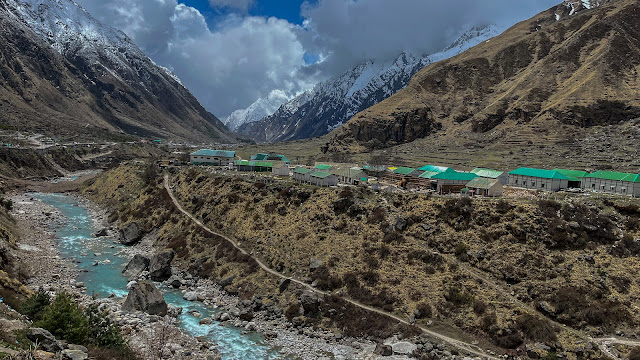.jpg) |
| Mana, the last village of India close to Tibet Border |
.jpg) |
| Gallis of Mana |
.jpg) |
| A wall art |
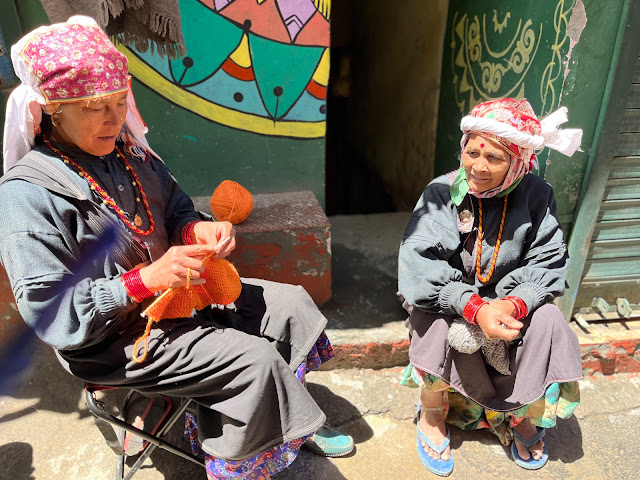 |
| Artisans in the Mana village |
But as the walk was quite long, we cut short our visit halfway through. This, proved to be a blessing in disguise as there was a heavy landslide en route just after we passed and people were stranded overnight on the road.
.jpg) |
| Devprayag, confluence of Alaknanda(left) and Bhagirathi (right) |
.jpg) |
| Another view of Devprayag |
On the way to Rudraprayag, we visited Dhari Devi temple at Kalyasaur on the banks of Alakananda River. It is dedicated to Goddess Dhari Devi who is considered as a manifestation of Goddess Kali. She is revered as a guardian deity who protects those who live there and the Char Dham Yatra Pilgrims. It is believed that relocating or disturbing the Devi's idol can bring about natural disasters. In 2013, it was forcibly relocated as part of a hydropower project. Within hours, there were devastating floods in Kedarnath proving the temple's protective powers.
 |
| Dhaari Devi Temple |
After resting at Rudraprayag, we reached Rishikesh in the evening to witness Ganga Arti in Triveni Ghat.
 |
| Ganga Aarti @ Triveni Ghat |

We savoured hot jalebis that were sold in a shop near the ghat.Haridwar
On the last day, visited Har Ki Pauri (Feet of Lord Vishnu) ghat which stands as a symbol of devotion, spirituality, and the rich cultural heritage of Haridwar. People across India come to this place to get a dip in the holy river Ganga.
 |
| River Ganga flowing in Haridwar |
 |
| Har ki Pauri (Feet of Lord Vishnu) Ghat |

This place was blazing hot. After encountering subzero temperatures at all the Dhams, we were now experiencing temperatures around 37 degree Celsius. Our area exploration was limited as it was a quick visit en route to the airport. Later had our lunch and proceeded to the airport.
As we departed, we couldn't help but acknowledge the abundant blessings of the Lord that had graced our journey throughout. We were fortunate not to encounter any delays or the typical adverse weather challenges often experienced during this pilgrimage.
"Travel not only to discover new places but to uncover the depths of your soul. In the sacred journey, you may find that the destination is not just a physical location, but a profound connection with the universe within and around you." - Unknown
As we concluded our Yatra, it became abundantly clear that this journey was far more than a mere trip; it was a profound soul-searching adventure that intimately connected us to the divine beauty of nature. It indeed was a once-in-a-lifetime experience. While our bodies had been weary, our spirits soared high, and our hearts overflowed with gratitude.
This Yatra has not just been a journey; it's been a revelation, a reminder that the truest treasures are the ones we carry in our hearts.
If you have reached here, I thank you for joining me on this virtual pilgrimage. Your feedback is most welcome and encourage you to share this with others who may find it informative and inspirational to undertake the Yatra.

.jpg)
.jpg)

.jpg)
.jpg)

.jpg)



.jpg)





.jpg)

.jpg)

.jpg)
.jpg)

.jpg)
.jpg)
.jpg)


.jpg)


.jpg)
.jpg)
.jpg)
.jpg)



.jpg)
.jpg)
.jpg)

.jpg)
.jpg)







.jpg)





.jpg)
.jpg)





.jpg)
.jpg)
.jpg)

.jpg)
.jpg)
.jpg)



.jpg)
.jpg)
.jpg)
.jpg)
.jpg)
.jpg)

.jpg)
.jpg)
No comments:
Post a Comment